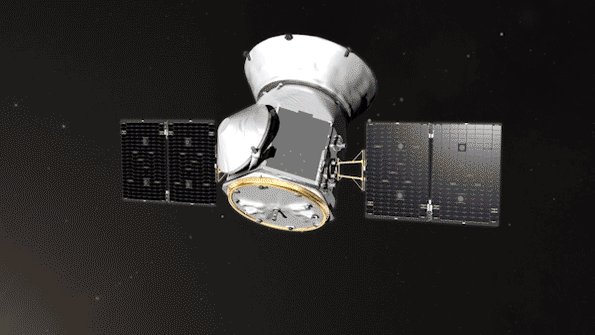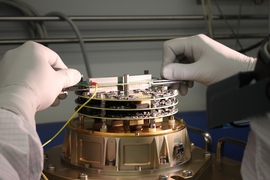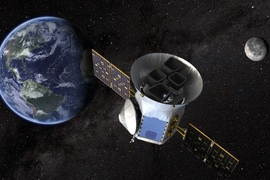There are potentially thousands of planets that lie just outside our solar system — galactic neighbors that could be rocky worlds or more tenuous collections of gas and dust. Where are these closest exoplanets located? And which of them might we be able to probe for clues to their composition and even habitability? The Transiting Exoplanet Survey Satellite (TESS) will be the first to seek out these nearby worlds.
The NASA-funded spacecraft, not much larger than a refrigerator, carries four cameras that were conceived, designed, and built at MIT, with one wide-eyed vision: to survey the nearest, brightest stars in the sky for signs of passing planets.
Now, more than a decade since MIT scientists first proposed the mission, TESS is about to get off the ground. The spacecraft is scheduled to launch on a SpaceX Falcon 9 rocket from Cape Canaveral Air Force Station in Florida, no earlier than April 16, at 6:32 p.m. EDT.

The Transiting Exoplanet Survey Satellite (TESS) will discover thousands of exoplanets in orbit around the brightest stars in the sky. In a two-year survey of the solar neighborhood, TESS will monitor more than 200,000 stars for temporary drops in brightness caused by planetary transits. This first-ever space borne all-sky transit survey will identify planets ranging from Earth-sized to gas giants, around a wide range of stellar types and orbital distances. No ground-based survey can achieve this feat. (NASA's Goddard Space Flight Center/CI Lab)
TESS will spend two years scanning nearly the entire sky — a field of view that can encompass more than 20 million stars. Scientists expect that thousands of these stars will host transiting planets, which they hope to detect through images taken with TESS’s cameras.
Amid this extrasolar bounty, the TESS science team at MIT aims to measure the masses of at least 50 small planets whose radii are less than four times that of Earth. Many of TESS’s planets should be close enough to our own that, once they are identified by TESS, scientists can zoom in on them using other telescopes, to detect atmospheres, characterize atmospheric conditions, and even look for signs of habitability.
“TESS is kind of like a scout,” says Natalia Guerrero, deputy manager of TESS Objects of Interest, an MIT-led effort that will catalog objects captured in TESS data that may be potential exoplanets.
“We’re on this scenic tour of the whole sky, and in some ways we have no idea what we will see,” Guerrero says. “It’s like we’re making a treasure map: Here are all these cool things. Now, go after them.”
A seed, planted in space
TESS’s origins arose from an even smaller satellite that was designed and built by MIT and launched into space by NASA on Oct. 9, 2000. The High Energy Transient Explorer 2, or HETE-2, orbited Earth for seven years, on a mission to detect and localize gamma-ray bursts — high-energy explosions that emit massive, fleeting bursts of gamma and X-rays.
To detect such extreme, short-lived phenomena, scientists at MIT, led by principal investigator George Ricker, integrated into the satellite a suite of optical and X-ray cameras outfitted with CCDs, or charge-coupled devices, designed to record intensities and positions of light in an electronic format.
“With the advent of CCDs in the 1970s, you had this fantastic device … which made a lot of things easier for astronomers,” says HETE-2 team member Joel Villasenor, who is now also instrument scientist for TESS. “You just sum up all the pixels on a CCD, which gives you the intensity, or magnitude, of light. So CCDs really broke things open for astronomy.”
In 2004, Ricker and the HETE-2 team wondered whether the satellite’s optical cameras could pick out other objects in the sky that had begun to attract the astronomy community: exoplanets. Around this time, fewer than 200 planets outside our solar system had been discovered. A few of these were found with a technique known as the transit method, which involves looking for periodic dips in the light from certain stars, which may signal a planet passing in front of the star.
“We were thinking, was the photometry of HETE-2’s cameras sufficient so that we could point to a part of the sky and detect one of these dips? Needless to say, it didn’t exactly work,” Villasenor recalls. “But that was sort of the seed that started us thinking, maybe we should try to fly CCDs with a camera to try and detect these things.”
A path, cleared
In 2006, Ricker and his team at MIT proposed a small, low cost satellite (HETE-S) to NASA as a Discovery class mission, and later on as a privately funded mission for $20 million. But as the cost of, and interest in, an all-sky exoplanet survey grew, they decided instead to seek NASA funding, at a higher level of $120 million. In 2008, they submitted a proposal for a NASA Small Explorer (SMEX) Class Mission with the new name — TESS.
At this time, the satellite design included six CCD cameras, and the team proposed that the spacecraft fly in a low-Earth orbit, similar to that of HETE-2. Such an orbit, they reasoned, should keep observing efficiency relatively high, as they already had erected data-receiving ground stations for HETE-2 that could also be put to use for TESS.
But they soon realized that a low-Earth orbit would have a negative impact on TESS’s much more sensitive cameras. The spacecraft’s reaction to the Earth’s magnetic field, for example, could lead to significant “spacecraft jitter,” producing noise that hides an exoplanet’s telltale dip in starlight.
NASA bypassed this first proposal, and the team went back to the drawing board, this time emerging with a new plan that hinged on a completely novel orbit. With the help of engineers from Orbital ATK, the Aerospace Corporation, and NASA’s Goddard Space Flight Center, the team identified a never-before-used “lunar-resonant” orbit that would keep the spacecraft extremely stable, while giving it a full-sky view.
Once TESS reaches this orbit, it will slingshot between the Earth and the moon on a highly elliptical path that could keep TESS orbiting for decades, shepherded by the moon’s gravitational pull.
“The moon and the satellite are in a sort of dance,” Villasenor says. “The moon pulls the satellite on one side, and by the time TESS completes one orbit, the moon is on the other side tugging in the opposite direction. The overall effect is the moon’s pull is evened out, and it’s a very stable configuration over many years. Nobody’s done this before, and I suspect other programs will try to use this orbit later on.”
In its current planned trajectory, TESS will swing out toward the moon for less than two weeks, gathering data, then swing back toward the Earth where, on its closest approach, it will transmit the data back to ground stations from 67,000 miles above the surface before swinging back out. Ultimately, this orbit will save TESS a huge amount of fuel, as it won’t need to burn its thrusters on a regular basis to keep on its path.
With this revamped orbit, the TESS team submitted a second proposal in 2010, this time as an Explorer class mission, which NASA approved in 2013. It was around this time that the Kepler Space Telescope ended its original survey for exoplanets. The observatory, which was launched in 2009, stared at one specific patch of the sky for four years, to monitor the light from distant stars for signs of transiting planets.
By 2013, two of Kepler’s four reaction wheels had worn out, preventing the spacecraft from continuing its original survey. At this point, the telescope’s measurements had enabled the discovery of nearly 1,000 confirmed exoplanets. Kepler, designed to study far-off stars, paved the way for TESS, a mission with a much wider view, to scan the nearest stars to Earth.
“Kepler went up, and was this huge success, and researchers said, ‘We can do this kind of science, and there are planets everywhere,” says TESS member Jennifer Burt, an MIT-Kavli postdoc. “And I think that was really the scientific check box that we needed for NASA to say, ‘Okay, TESS makes a lot of sense now.’ It’ll enable not just detecting planets, but finding planets that we can thoroughly characterize after the fact.”
Stripes in the sky
With the selection by NASA, the TESS team set up facilities on campus and in MIT’s Lincoln Laboratory to build and test the spacecraft’s cameras. The engineers designed “deep depletion” CCDs specifically for TESS, meaning that the cameras can detect light over a wide range of wavelengths up to the near infrared. This is important, as many of the nearby stars TESS will monitor are red-dwarfs — small, cool stars that emit less brightly than the sun and in the infrared part of the electromagnetic spectrum.
If scientists can detect periodic dips in the light from such stars, this may signal the presence of planets with significantly tighter orbits than that of Earth. Nevertheless, there is a chance that some of these planets may be within the “habitable zone,” as they would circle much cooler stars, compared with the sun. Since these stars are relatively close by, scientists can do follow-up observations with ground-based telescopes to help identify whether conditions might indeed be suitable for life.
TESS’s cameras are mounted on the top of the satellite and surrounded by a protective cone to shield them from other forms of electromagnetic radiation. Each camera has a 24 by 24 degree view of the sky, large enough to encompass the Orion constellation. The satellite will start its observations in the Southern Hemisphere and will divide the sky into 13 stripes, monitoring each segment for 27 days before pivoting to the next. TESS should be able to observe nearly the entire sky in the Southern Hemisphere in its first year, before moving on to the Northern Hemisphere in its second year.
While TESS points at one stripe of the sky, its cameras will take pictures of the stars in that portion. Ricker and his colleagues have made a list of 200,000 nearby, bright stars that they would particularly want to observe. The satellite’s cameras will create “postage stamp” images that include pixels around each of these stars. These images will be taken every two minutes, in order to maximize the chance of catching the moment that a planet crosses in front of its star. The cameras will also take full-frame images of all the stars in a particular stripe of the sky, every 30 minutes.
“With the two-minute pictures, you can get a movie-like image of what the starlight is doing as the planet is crossing in front of its host star,” Guerrero says. “For the 30-minute images, people are excited about maybe seeing supernovae, asteroids, or counterparts to gravitational waves. We have no idea what we’re going to see at that timescale.”
Are we alone?
After TESS launches, the team expects that the satellite will reestablish contact within the first week, during which it will turn on all its instruments and cameras. Then, there will be a 60-day commissioning phase, as engineers and scientists at Orbital ATK, NASA, and MIT calibrate the instruments and monitor the satellite’s trajectory and performance. After that, TESS will begin to collect and downlink images of the sky. Scientists at MIT and NASA will take the raw data and convert it into light curves that indicate the changing brightness of a star over time.
From there, the TESS Science Team, including Sara Seager, the Class of 1941 Professor of Earth, Atmospheric and Planetary Sciences, and deputy director of science for TESS, will look through thousands of light curves, for at least two similar dips in starlight, indicating that a planet may have passed twice in front of its star. Seager and her colleagues will then employ a battery of methods to determine the mass of a potential planet.
“Mass is a defining planetary characteristic,” Seager says. “If you just know that a planet is twice the size of Earth, it could be a lot of things: a rocky world with a thin atmosphere, or what we call a “mini-Neptune” — a rocky world with a giant gas envelope, where it would be a huge greenhouse blanket, and there would be no life on the surface. So mass and size together give us an average planet density, which tells us a huge amount about what the planet is.”
During TESS’s two-year mission, Seager and her colleagues aim to measure the masses of 50 planets with radii less than four times that of Earth — dimensions that could signal further observations for signs of habitability. Meanwhile, the whole scientific community and public will get a chance to search through TESS data for their own exoplanets. Once the data are calibrated, the team will make them publicly available. Anyone will be able to download the data and draw their own interpretations, including high school students, armchair astronomers, and other research institutions.
With so many eyes on TESS’S data, Seager says there’s a chance that, some day, a nearby planet discovered by TESS might be found to have signs of life.
“There’s no science that will tell us life is out there right now, except that small rocky planets appear to be incredibly common,” Seager says. “They appear to be everywhere we look. So it’s got to be there somewhere.”
TESS is a NASA Astrophysics Explorer mission led and operated by MIT in Cambridge, Massachusetts, and managed by NASA’s Goddard Space Flight Center in Greenbelt, Maryland. George Ricker of MIT’s Kavli Institute for Astrophysics and Space Research serves as principal investigator for the mission. Additional partners include Orbital ATK, NASA’s Ames Research Center, the Harvard-Smithsonian Center for Astrophysics, and the Space Telescope Science Institute. More than a dozen universities, research institutes, and observatories worldwide are participants in the mission.


















